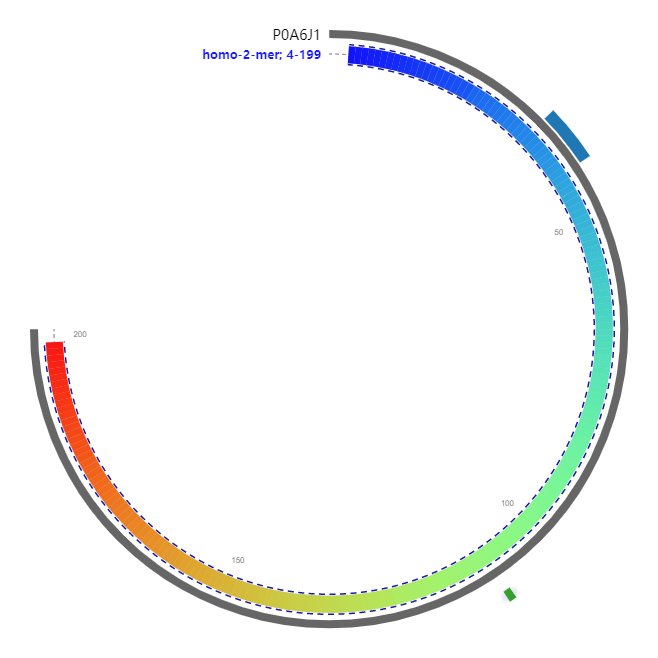Catalyzes the synthesis of activated sulfate.
MALHDENVVWHSHPVTVQQRELHHGHRGVVLWFTGLSGSGKSTVAGALEEALHKLGVSTY
LLDGDNVRHGLCSDLGFSDADRKENIRRVGEVANLMVEAGLVVLTAFISPHRAERQMVRE
RVGEGRFIEVFVDTPLAICEARDPKGLYKKARAGELRNFTGIDSVYEAPESAEIHLNGEQ
LVTNLVQQLLDLLRQNDIIRS
205

| PMID | Title & Author | Abstract | Year | |
| 0 | 1316900 | The DNA sequence of the sulfate activation locus from Escherichia coli K-12.Leyh TS, Vogt TF, Suo Y | The DNA sequence of the sulfate activation locus from Escherichia coli K-12 has been determined. The sequence includes the structural genes encoding the enzymes ATP sulfurylase (cysD and cysN) and APS kinase (cysC) which catalyze the synthesis of activated sulfate. These are the only genes known to reside in the sulfate activation operon. Consensus elements of the operon promoter were identified, and the start codons and open reading frames of the Cys polypeptides were determined. During this work, another gene, iap, was partially sequenced and mapped. The activity of ATP sulfurylase is stimulated by an intrinsic GTPase. Comparison of the primary sequences of CysN and Ef-Tu revealed that CysN has conserved many of the residues integral to the three-dimensional structure important for guanine nucleotide binding in Ef-Tu and RAS. nodP and nodQ, from Rhizobium meliloti, are essential for nodulation in leguminous plants. The Cys and Nod proteins are remarkably similar. NodP appears to be the smaller subunit of ATP sulfurylase. NodQ encodes homologues of both CysN and CysC; thus, these enzymes may be covalently associated in R. meliloti. The consensus GTP-binding sequences of NodQ and CysN are identical suggesting that NodQ encodes a regulatory GTPase. | 1992 |
| 1 | 2158792 | Molecular cloning of the cys genes (cysC, cysD, cysH, cysI, cysJ, and cysG) responsible for cysteine biosynthesis in Escherichia coli K-12.H Tei , K Murata, A Kimura | The cysCDHIJ gene region at 59 min and the cysG gene at 74 min on the chromosome of Escherichia coli K-12 were cloned. The ability of these cloned genes to complement mutants was analyzed and their restriction maps were determined. The following results were obtained. First, the cysCDHIJ regulon could be separated into cysCD and cysHIJ regions. Second, the cysG gene was quite different from the cysI and cysJ genes. | 1990 |
| 2 | 25807013 | Crystal structures of the kinase domain of the sulfate-activating complex in Mycobacterium tuberculosis.Ömer Poyraz , Katharina Brunner , Bernhard Lohkamp , Hanna Axelsson , Lars G J Hammarström , Robert Schnell , Gunter Schneider | In Mycobacterium tuberculosis the sulfate activating complex provides a key branching point in sulfate assimilation. The complex consists of two polypeptide chains, CysD and CysN. CysD is an ATP sulfurylase that, with the energy provided by the GTPase activity of CysN, forms adenosine-5'-phosphosulfate (APS) which can then enter the reductive branch of sulfate assimilation leading to the biosynthesis of cysteine. The CysN polypeptide chain also contains an APS kinase domain (CysC) that phosphorylates APS leading to 3'-phosphoadenosine-5'-phosphosulfate, the sulfate donor in the synthesis of sulfolipids. We have determined the crystal structures of CysC from M. tuberculosis as a binary complex with ADP, and as ternary complexes with ADP and APS and the ATP mimic AMP-PNP and APS, respectively, to resolutions of 1.5 Å, 2.1 Å and 1.7 Å, respectively. CysC shows the typical APS kinase fold, and the structures provide comprehensive views of the catalytic machinery, conserved in this enzyme family. Comparison to the structure of the human homolog show highly conserved APS and ATP binding sites, questioning the feasibility of the design of specific inhibitors of mycobacterial CysC. Residue Cys556 is part of the flexible lid region that closes off the active site upon substrate binding. Mutational analysis revealed this residue as one of the determinants controlling lid closure and hence binding of the nucleotide substrate. | 2015 |
Leyh T S , Vogt T F , Suo Y . The DNA sequence of the sulfate activation locus from Escherichia coli K-12. J Biol Chem[J]. Journal of Biological Chemistry, 1992, 267(15):10405-10.